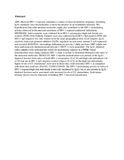| dc.contributor.author | Hirbod, T | |
| dc.contributor.author | Reichard, C | |
| dc.contributor.author | Hasselrot, K | |
| dc.contributor.author | Söderlund, J | |
| dc.contributor.author | Kimani, J | |
| dc.contributor.author | Bwayo, JJ | |
| dc.contributor.author | Plummer, F | |
| dc.contributor.author | Kaul, R | |
| dc.contributor.author | Broliden, K | |
| dc.date.accessioned | 2013-06-29T10:36:19Z | |
| dc.date.available | 2013-06-29T10:36:19Z | |
| dc.date.issued | 2008 | |
| dc.identifier.citation | Hirbod T, Reichard C, Hasselrot K, Söderlund J, Kimani J, Bwayo JJ, Plummer F, Kaul R, Broliden K; HIV-1 neutralizing activity is correlated with increased levels of chemokines in saliva of HIV-1-exposed uninfected individuals.;Curr HIV Res. 2008 Jan;6(1):28-33. | en |
| dc.identifier.issn | 1570-162X | |
| dc.identifier.uri | http://www.ncbi.nlm.nih.gov/pubmed/18288972 | |
| dc.identifier.uri | http://erepository.uonbi.ac.ke:8080/xmlui/handle/123456789/42352 | |
| dc.description.abstract | AIM:
Mucosal HIV-1 exposure stimulates a variety of mucosal immune responses, including IgA1-mediated virus neutralization, even in the absence of an established infection. We hypothesized that other immune molecules might also contribute to the HIV-1 neutralizing activity observed in the mucosal secretions of HIV-1 exposed uninfected individuals.
METHODS:
Saliva samples were collected from HIV-1 seronegative high-risk female sex workers (FSW) from Nairobi. Samples were also collected from HIV-1 IgG positive FSW and HIV-1 IgG negative low-risk women from the same geographical area. In all samples, IgA2, secretory leukocyte protease inhibitor (SLPI), regulated on activation, normal T-cell expressed and secreted (RANTES), macrophage inflammatory protein 1 alpha and beta (MIP-1alpha and -beta) and monocyte chemoattractant protein-1 (MCP-1) were quantified. The IgA1-depleted saliva samples were subsequently tested for neutralizing capacity in a PBMC-based neutralization assay using a primary HIV-1 clade A isolate to determine biological relevance of the measured molecules.
RESULTS:
HIV-1 specific neutralization was present in the IgA1-depleted fraction from saliva of both HIV-1 seropositive (9 of 10) and high-risk individuals (36 of 45) but not in HIV-1 IgG-negative control subjects (0 of 8). In the high-risk individuals, higher levels of CC-chemokines were seen in those that could neutralize HIV-1 as compared with those that could not (P<0.05).
CONCLUSION:
The HIV-1 neutralizing activity in saliva of HIV-1-exposed high-risk individuals is not only mediated by IgA1, but is also present in IgA1-depleted fractions and is associated with increased levels of CC-chemokines. Such innate immune factors may be important in limiting HIV-1 mucosal transmission. | en |
| dc.language.iso | en | en |
| dc.publisher | University of Nairobi, | en |
| dc.subject | HIV-1 | en |
| dc.subject | chemokines | en |
| dc.subject | IgA2 | en |
| dc.subject | Neutralization | en |
| dc.subject | , SLP1 | en |
| dc.title | HIV-1 neutralizing activity is correlated with increased levels of chemokines in saliva of HIV-1-exposed uninfected individuals. | en |
| dc.type | Article | en |
| local.publisher | College of Health Sciences, | en |

